From the Editor: Living in the Moment
Breed, Landrace and Purity:
what do they mean?
In the News
QTC Update: final report
Veterinary Service Plans for the Eastern Canadian Arctic
Piksuk Media Projects
CAAT Welcomed Back to Baker Lake
Join the Primitive Aboriginal Dog Society International
Media Review: People of the Seal, Part 2
IMHO: Relationships and Inclusion
Navigating This Site
Index of articles by subject
Index of back issues by volume number
Search The Fan Hitch
Articles to download and print
Ordering Ken MacRury's Thesis
Our comprehensive list of resources
Talk to The Fan Hitch
The Fan Hitch home page
ISDI home page
Editor's/Publisher's Statement
Editor: Sue Hamilton
Webmaster: Mark Hamilton
The Fan Hitch, Journal of
the Inuit Sled Dog, is published four times
a year. It is available at no cost online
at: https://thefanhitch.org.
The Fan Hitch welcomes your letters, stories, comments and suggestions. The editorial staff reserves the right to edit submissions used for publication.
Contents of The Fan Hitch are protected by international copyright laws. No photo, drawing or text may be reproduced in any form without written consent. Webmasters please note: written consent is necessary before linking this site to yours! Please forward requests to Sue Hamilton, 55 Town Line Rd., Harwinton, Connecticut 06791, USA or mail@thefanhitch.org.
This site is dedicated to the Inuit Dog as well as related Inuit culture and traditions. It is also home to The Fan Hitch, Journal of the Inuit Sled Dog.
The Fan Hitch welcomes your letters, stories, comments and suggestions. The editorial staff reserves the right to edit submissions used for publication.
Contents of The Fan Hitch are protected by international copyright laws. No photo, drawing or text may be reproduced in any form without written consent. Webmasters please note: written consent is necessary before linking this site to yours! Please forward requests to Sue Hamilton, 55 Town Line Rd., Harwinton, Connecticut 06791, USA or mail@thefanhitch.org.
This site is dedicated to the Inuit Dog as well as related Inuit culture and traditions. It is also home to The Fan Hitch, Journal of the Inuit Sled Dog.
People of
the Seal, Part 2
an archival documentary film
reviewed by Sue Hamilton
an archival documentary film
reviewed by Sue Hamilton
The history of mushing did not begin with the Alaskan gold rush or during the Serum Run era, as some have described, any more than the history of the wheel began with the horse and buggy. All too often it seems that sled dog "historians" may (or may not) offer paltry lip service to or acknowledgement of Inuit contributions and ingenuity regarding the origin of dog powered transportation on snow.
The use of dogs for pulling begins with the creation of the device to which the dogs are attached. According to Ken MacRury's master's thesis, The Inuit Dog: Its Provenance, Environment and History, North American archaeologists found sled parts attributed to the Thule culture (ancestors of today's Inuit) dating back to 800 BP (Before Present: dating scale now used by archaeologists was established 1950 as the origin year for the BP scale. The year 1950 was chosen because it is the year in which calibration curves for radiocarbon dating were established. Wikipedia) And so, long before carbon fiber components and quick-change runners common to today's world of sled dog racing, the ancestors of today's circumpolar Inuit built their qamutiit (sleds) out of animal parts.
Fortunately the fabrication of this ingenious design has been recorded for posterity and is available from the National Film Board of Canada (NFB). The NFB has a massive collection of documentaries about the Netsilik Inuit, also referred to as the "People of the Seal", and there's one in particular (actually it is the second of a two-part series, filmed in 1965) that meticulously recorded the creation of a qamutiq, made entirely of materials harvested from land and sea. The Fan Hitch is enormously grateful to the NFB for granting us permission to publish screen captures from this documentary so readers can see the steps involved in the process.
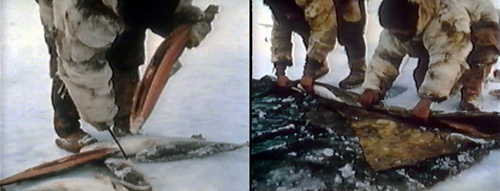
| Frozen
fish, likely char, are split from nose to tail. |
Split
fish,
nose to tail and overlaping, laid out along one
end of a soaked seal hide, are rolled up. Note:
bare hands at minus 40F/C |
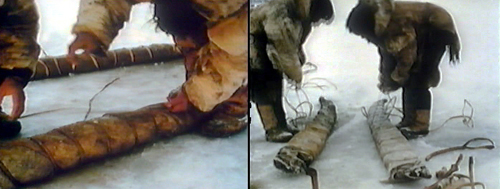
| The
hide-wrapped fish are lashed and kept that way
until thoroughly frozen. |
The
leather thongs are removed. Note the upturned
(front) ends and how well both runners appear to
be dimensionally matched. |
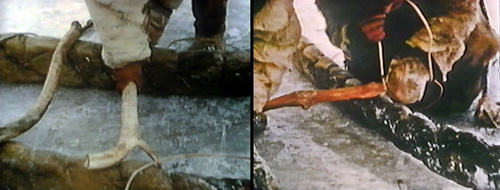
| Caribou
antlers or leg bones serve as the cross-pieces
holding runners in place. The runners need to be
parallel and also at a slight angle to the ice
for best tracking. Note: no fancy tools! |
Long
thin strips of bearded seal are used to lash
everything together, pulling the line as tight
as possible. |
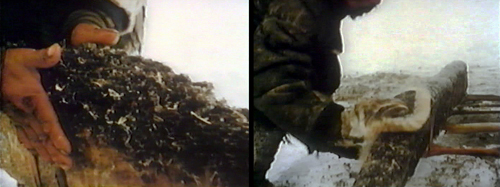
| With the
qamutiq upside, down a water-laden moss/mud
matrix is piled on the bottom of the fish-core,
seal hide runners. |
After
shaping
the frozen moss-mud runner, melt-water is
squirted onto a section polar bear fur from the
mouth. Rubbed over the moss, gaps are
filled and an ice runner is formed. Damage to
ice runners must be repaired immediately. |
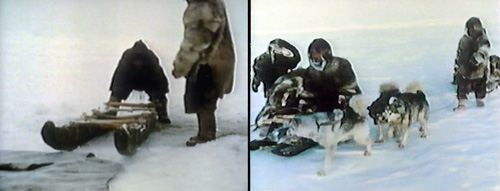
| It is now a
means of survival as long as temperatures remain
below freezing and hungry dogs are kept away! |
It
is a marvel of ingenuity, built with a knife. |
People of the Seal, Part 2: Eskimo Winter is available in Canada as a DVD for $19.95 CAD plus shipping. For availability in other countries, please call 1-800-267-7710 or 1-514-283-9000 (Montreal, Canada) or write: National Film Board of Canada, Sales and Customer Service, D-10 PO Box 6100, Station Centre-Ville, Montreal, Quebec H3C 3H5, Canada. You may email your inquiry by using the form on the NFB's "contact us" page.